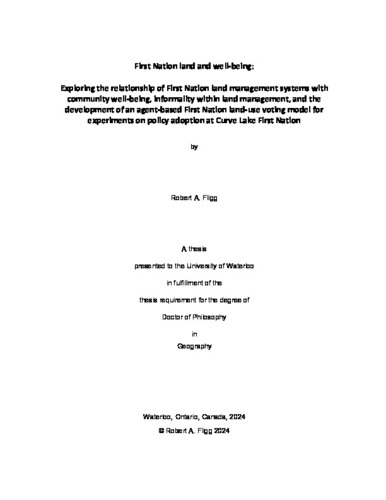| dc.description.abstract | Land management is a pressing issue for reconciling and reconnecting First Nations with their land. Many First Nations have taken more control and responsibility over the management of their land that is key to their well-being. Currently, two legislative pathways (e.g., the First Nation Land Management (FNLM) regime and frameworks of self-government) provide more control by First Nations over their land outside of the Indian Act, however, there are gaps in societies’ understanding about the relationship of First Nation land management (in the broader sense) and their well-being.
The overarching goal of the dissertation, seeks to improve societies’ understanding about the relationship between First Nation land management (broadly defined, including land management systems, property rights systems, land-use policies and planning) and First Nation well-being. Chapter 2 contributes by asking the question: “does the land-management regime of a First Nation correlate with differing levels of community well-being among First Nations as measured using the community well-being (CWB) index?”. It also investigates if there have been temporal effects by asking the question: “do First Nation communities experience different CWB trajectories when under a particular land management regime when they transition from one land management regime to another?” First Nation communities that have more control over managing their land have on average higher CWB scores, however, a community under any land management regime (e.g., under the Indian Act, or sub-set of the Indian Act ‘Reserve Land and Environment Management Program’ (RLEMP), Framework Agreement on First Nation Land Management Act (formerly First Nations Land Management Act (FNLM)) or a framework of self-government) could achieve a high CWB score (e.g., above the non-Indigenous average) depending on key economic factors (e.g., location of a community to an economic area). Regardless of CWB scores a land management regime is crucial to First Nation cultural well-being that may include pathways or mechanisms to develop formal community objectives and policies on land-use practices (e.g., on land relationships and stewardship).
Building on Chapter 2, Chapter 3 looks deeper into First Nation land management, land-use practices, policy and planning, and property rights through collaboration with Curve Lake First Nation. Chapter 3 investigates by First Nation member-type (i.e., land holder vs non-land holder, and ‘on’ vs ‘off-reserve’ members) land management knowledge, and the impact member type has on land management and land-use practices. To achieve the objective of Chapter 3, a social survey was created in collaboration with Curve Lake First Nation to investigate formal and informal land-use practices and policy in land management, and whether there was a gap between members “wants and needs” regarding what should happen according to (formal) policy or process and what actually happens on the ground (informal). Although results from Chapter 3 found a correlation of land holder/non-land holder disconnect with uncertainty regarding policy on land use-practices that suggested a need for formal land-use policy and planning, the results also suggested CP holders and non-CP holders agreed that all parcels should be managed and used according to community values.
Chapter 4 takes a step toward filling the gap in societies’ understanding by utilizing the knowledge and data from Chapters 2 and 3 in the development of a First Nation land-use voting model to investigate how formal land use policy on individual support for land policy and community land objectives could be conceptualized as a collective well-being. Chapter 4 investigated the objective by asking research questions on “how different member-levels of propensity for land information knowledge, ambition, stewardship, and how they collaborate affect formal land-use plan and potential land-policy adoption”, and secondly “how relationships and changes in members’ knowledge and attitudes affect support of formal land-use policy and its potential adoption?” Responses to the Curve Lake First Nation social survey was further coded for member responses on land related questions about their community, and outside community, on systems of land management, property rights, land-use policy and planning, and opinions on well-being that could be used to empirically inform an agent-based model called the ‘First Nation Land-Use Voting Model’. Model results suggest with greater support for community specific objectives for a balance in socio-economic and cultural well-being, there is greater support for the adoption of formal land-use policy and planning. | en |

